Comprehensive Analysis: UK Oil Retail Market Dynamics Report
VerifiedAdded on 2020/05/01
|10
|2373
|62
Report
AI Summary
This report provides a comprehensive analysis of the UK oil retail market, examining its structure, key business drivers, and the influence of governmental actions and technological changes. It delves into the competitive landscape, highlighting the importance of consumer preferences, particularly price and convenience, and the impact of hypermarket entry. The report analyzes the factors affecting the market's size and structure, including consumer needs, location, and the role of fuel suppliers. It critically assesses the influence of government regulations, fiscal policies, and environmental measures on the petroleum retail sector, including the impact of VAT and duty on fuel. Furthermore, the report evaluates the potential of technological advancements, such as smart POS systems and digital oil field technologies, on the energy retailing industry. It concludes with recommendations for adapting to the uncertain global oil prices and the adoption of digital technologies, emphasizing the importance of data security, cultural development, and effective leadership for future success in the UK oil retail market.
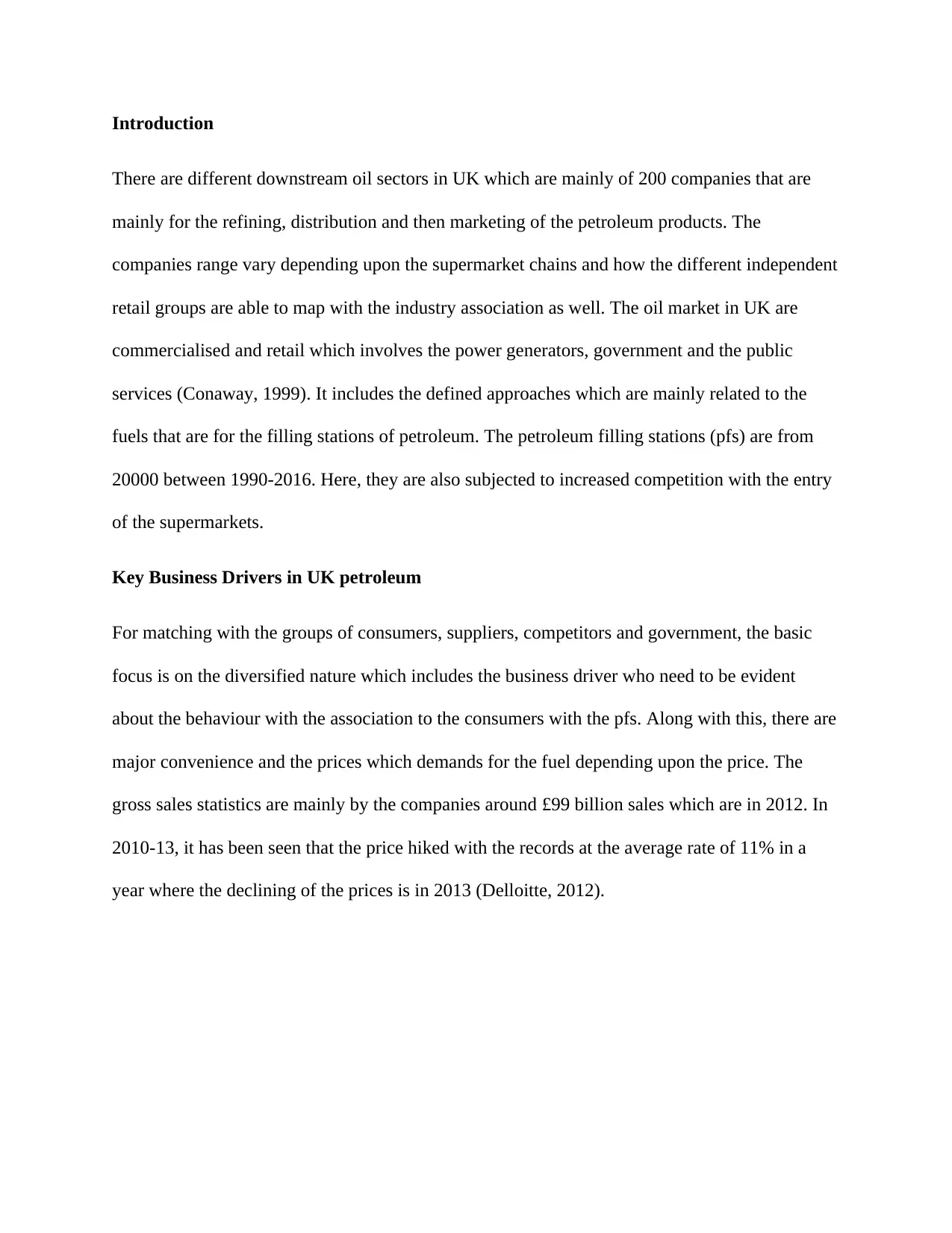
Introduction
There are different downstream oil sectors in UK which are mainly of 200 companies that are
mainly for the refining, distribution and then marketing of the petroleum products. The
companies range vary depending upon the supermarket chains and how the different independent
retail groups are able to map with the industry association as well. The oil market in UK are
commercialised and retail which involves the power generators, government and the public
services (Conaway, 1999). It includes the defined approaches which are mainly related to the
fuels that are for the filling stations of petroleum. The petroleum filling stations (pfs) are from
20000 between 1990-2016. Here, they are also subjected to increased competition with the entry
of the supermarkets.
Key Business Drivers in UK petroleum
For matching with the groups of consumers, suppliers, competitors and government, the basic
focus is on the diversified nature which includes the business driver who need to be evident
about the behaviour with the association to the consumers with the pfs. Along with this, there are
major convenience and the prices which demands for the fuel depending upon the price. The
gross sales statistics are mainly by the companies around £99 billion sales which are in 2012. In
2010-13, it has been seen that the price hiked with the records at the average rate of 11% in a
year where the declining of the prices is in 2013 (Delloitte, 2012).
There are different downstream oil sectors in UK which are mainly of 200 companies that are
mainly for the refining, distribution and then marketing of the petroleum products. The
companies range vary depending upon the supermarket chains and how the different independent
retail groups are able to map with the industry association as well. The oil market in UK are
commercialised and retail which involves the power generators, government and the public
services (Conaway, 1999). It includes the defined approaches which are mainly related to the
fuels that are for the filling stations of petroleum. The petroleum filling stations (pfs) are from
20000 between 1990-2016. Here, they are also subjected to increased competition with the entry
of the supermarkets.
Key Business Drivers in UK petroleum
For matching with the groups of consumers, suppliers, competitors and government, the basic
focus is on the diversified nature which includes the business driver who need to be evident
about the behaviour with the association to the consumers with the pfs. Along with this, there are
major convenience and the prices which demands for the fuel depending upon the price. The
gross sales statistics are mainly by the companies around £99 billion sales which are in 2012. In
2010-13, it has been seen that the price hiked with the records at the average rate of 11% in a
year where the declining of the prices is in 2013 (Delloitte, 2012).
Paraphrase This Document
Need a fresh take? Get an instant paraphrase of this document with our AI Paraphraser
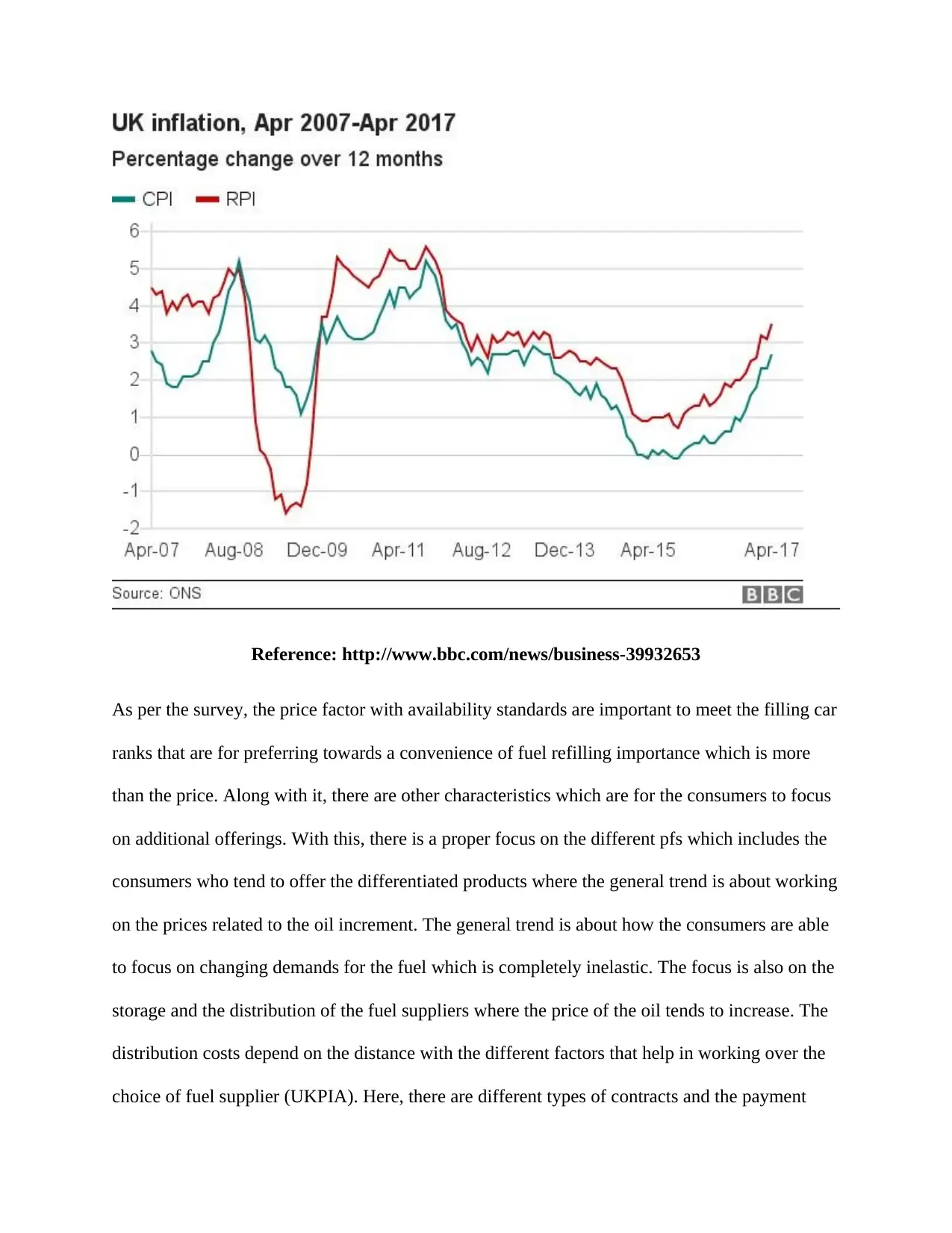
Reference: http://www.bbc.com/news/business-39932653
As per the survey, the price factor with availability standards are important to meet the filling car
ranks that are for preferring towards a convenience of fuel refilling importance which is more
than the price. Along with it, there are other characteristics which are for the consumers to focus
on additional offerings. With this, there is a proper focus on the different pfs which includes the
consumers who tend to offer the differentiated products where the general trend is about working
on the prices related to the oil increment. The general trend is about how the consumers are able
to focus on changing demands for the fuel which is completely inelastic. The focus is also on the
storage and the distribution of the fuel suppliers where the price of the oil tends to increase. The
distribution costs depend on the distance with the different factors that help in working over the
choice of fuel supplier (UKPIA). Here, there are different types of contracts and the payment
As per the survey, the price factor with availability standards are important to meet the filling car
ranks that are for preferring towards a convenience of fuel refilling importance which is more
than the price. Along with it, there are other characteristics which are for the consumers to focus
on additional offerings. With this, there is a proper focus on the different pfs which includes the
consumers who tend to offer the differentiated products where the general trend is about working
on the prices related to the oil increment. The general trend is about how the consumers are able
to focus on changing demands for the fuel which is completely inelastic. The focus is also on the
storage and the distribution of the fuel suppliers where the price of the oil tends to increase. The
distribution costs depend on the distance with the different factors that help in working over the
choice of fuel supplier (UKPIA). Here, there are different types of contracts and the payment
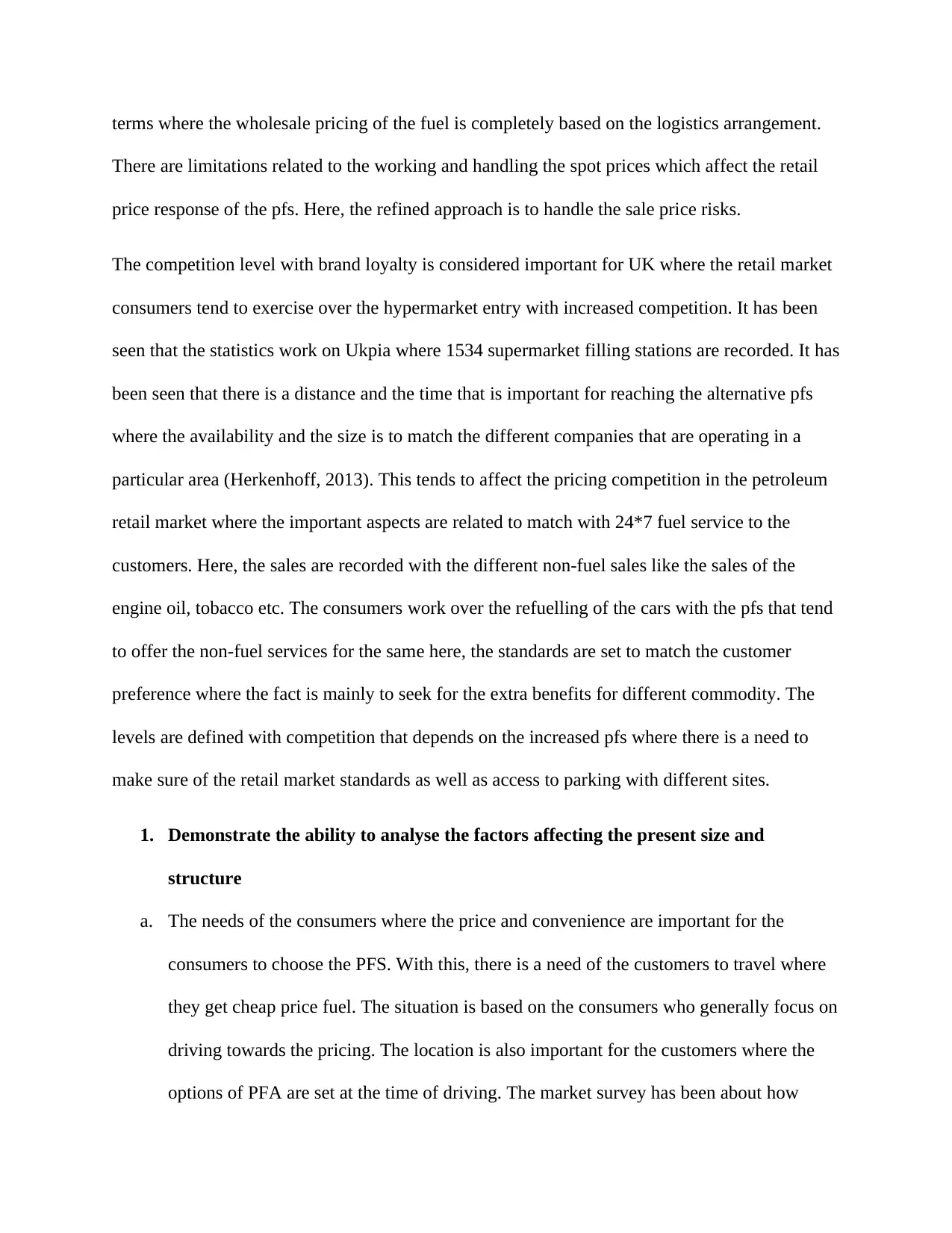
terms where the wholesale pricing of the fuel is completely based on the logistics arrangement.
There are limitations related to the working and handling the spot prices which affect the retail
price response of the pfs. Here, the refined approach is to handle the sale price risks.
The competition level with brand loyalty is considered important for UK where the retail market
consumers tend to exercise over the hypermarket entry with increased competition. It has been
seen that the statistics work on Ukpia where 1534 supermarket filling stations are recorded. It has
been seen that there is a distance and the time that is important for reaching the alternative pfs
where the availability and the size is to match the different companies that are operating in a
particular area (Herkenhoff, 2013). This tends to affect the pricing competition in the petroleum
retail market where the important aspects are related to match with 24*7 fuel service to the
customers. Here, the sales are recorded with the different non-fuel sales like the sales of the
engine oil, tobacco etc. The consumers work over the refuelling of the cars with the pfs that tend
to offer the non-fuel services for the same here, the standards are set to match the customer
preference where the fact is mainly to seek for the extra benefits for different commodity. The
levels are defined with competition that depends on the increased pfs where there is a need to
make sure of the retail market standards as well as access to parking with different sites.
1. Demonstrate the ability to analyse the factors affecting the present size and
structure
a. The needs of the consumers where the price and convenience are important for the
consumers to choose the PFS. With this, there is a need of the customers to travel where
they get cheap price fuel. The situation is based on the consumers who generally focus on
driving towards the pricing. The location is also important for the customers where the
options of PFA are set at the time of driving. The market survey has been about how
There are limitations related to the working and handling the spot prices which affect the retail
price response of the pfs. Here, the refined approach is to handle the sale price risks.
The competition level with brand loyalty is considered important for UK where the retail market
consumers tend to exercise over the hypermarket entry with increased competition. It has been
seen that the statistics work on Ukpia where 1534 supermarket filling stations are recorded. It has
been seen that there is a distance and the time that is important for reaching the alternative pfs
where the availability and the size is to match the different companies that are operating in a
particular area (Herkenhoff, 2013). This tends to affect the pricing competition in the petroleum
retail market where the important aspects are related to match with 24*7 fuel service to the
customers. Here, the sales are recorded with the different non-fuel sales like the sales of the
engine oil, tobacco etc. The consumers work over the refuelling of the cars with the pfs that tend
to offer the non-fuel services for the same here, the standards are set to match the customer
preference where the fact is mainly to seek for the extra benefits for different commodity. The
levels are defined with competition that depends on the increased pfs where there is a need to
make sure of the retail market standards as well as access to parking with different sites.
1. Demonstrate the ability to analyse the factors affecting the present size and
structure
a. The needs of the consumers where the price and convenience are important for the
consumers to choose the PFS. With this, there is a need of the customers to travel where
they get cheap price fuel. The situation is based on the consumers who generally focus on
driving towards the pricing. The location is also important for the customers where the
options of PFA are set at the time of driving. The market survey has been about how
⊘ This is a preview!⊘
Do you want full access?
Subscribe today to unlock all pages.

Trusted by 1+ million students worldwide
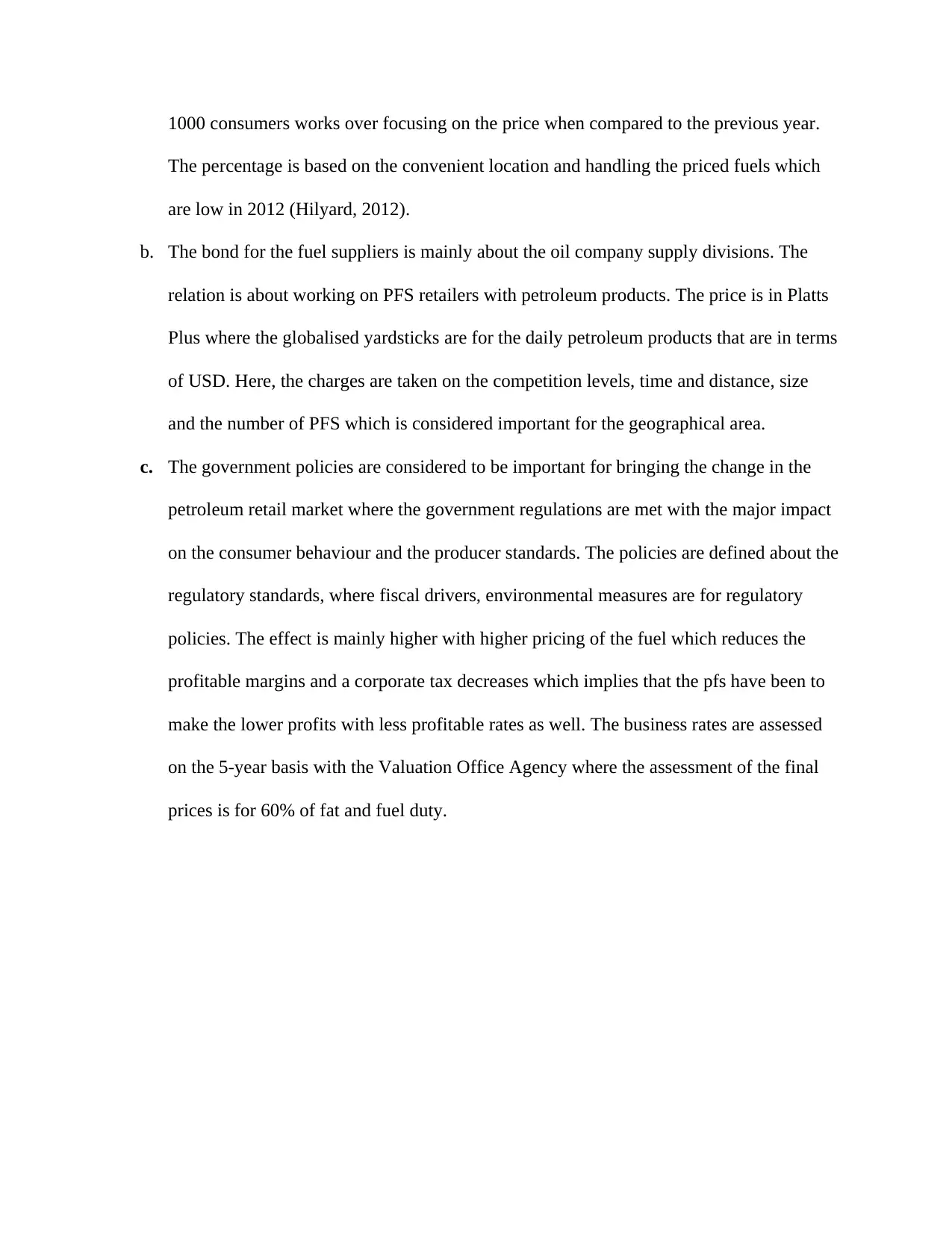
1000 consumers works over focusing on the price when compared to the previous year.
The percentage is based on the convenient location and handling the priced fuels which
are low in 2012 (Hilyard, 2012).
b. The bond for the fuel suppliers is mainly about the oil company supply divisions. The
relation is about working on PFS retailers with petroleum products. The price is in Platts
Plus where the globalised yardsticks are for the daily petroleum products that are in terms
of USD. Here, the charges are taken on the competition levels, time and distance, size
and the number of PFS which is considered important for the geographical area.
c. The government policies are considered to be important for bringing the change in the
petroleum retail market where the government regulations are met with the major impact
on the consumer behaviour and the producer standards. The policies are defined about the
regulatory standards, where fiscal drivers, environmental measures are for regulatory
policies. The effect is mainly higher with higher pricing of the fuel which reduces the
profitable margins and a corporate tax decreases which implies that the pfs have been to
make the lower profits with less profitable rates as well. The business rates are assessed
on the 5-year basis with the Valuation Office Agency where the assessment of the final
prices is for 60% of fat and fuel duty.
The percentage is based on the convenient location and handling the priced fuels which
are low in 2012 (Hilyard, 2012).
b. The bond for the fuel suppliers is mainly about the oil company supply divisions. The
relation is about working on PFS retailers with petroleum products. The price is in Platts
Plus where the globalised yardsticks are for the daily petroleum products that are in terms
of USD. Here, the charges are taken on the competition levels, time and distance, size
and the number of PFS which is considered important for the geographical area.
c. The government policies are considered to be important for bringing the change in the
petroleum retail market where the government regulations are met with the major impact
on the consumer behaviour and the producer standards. The policies are defined about the
regulatory standards, where fiscal drivers, environmental measures are for regulatory
policies. The effect is mainly higher with higher pricing of the fuel which reduces the
profitable margins and a corporate tax decreases which implies that the pfs have been to
make the lower profits with less profitable rates as well. The business rates are assessed
on the 5-year basis with the Valuation Office Agency where the assessment of the final
prices is for 60% of fat and fuel duty.
Paraphrase This Document
Need a fresh take? Get an instant paraphrase of this document with our AI Paraphraser
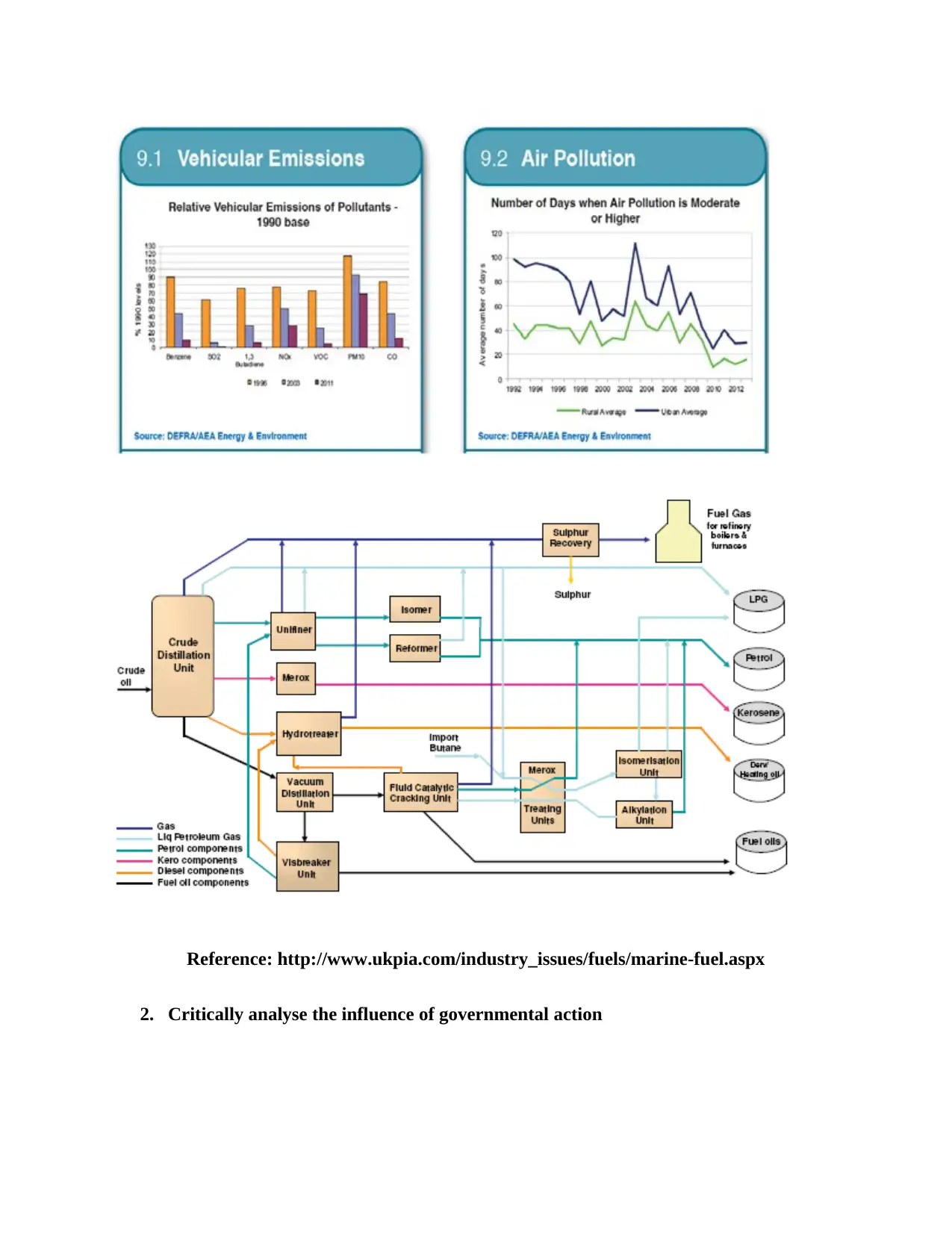
Reference: http://www.ukpia.com/industry_issues/fuels/marine-fuel.aspx
2. Critically analyse the influence of governmental action
2. Critically analyse the influence of governmental action
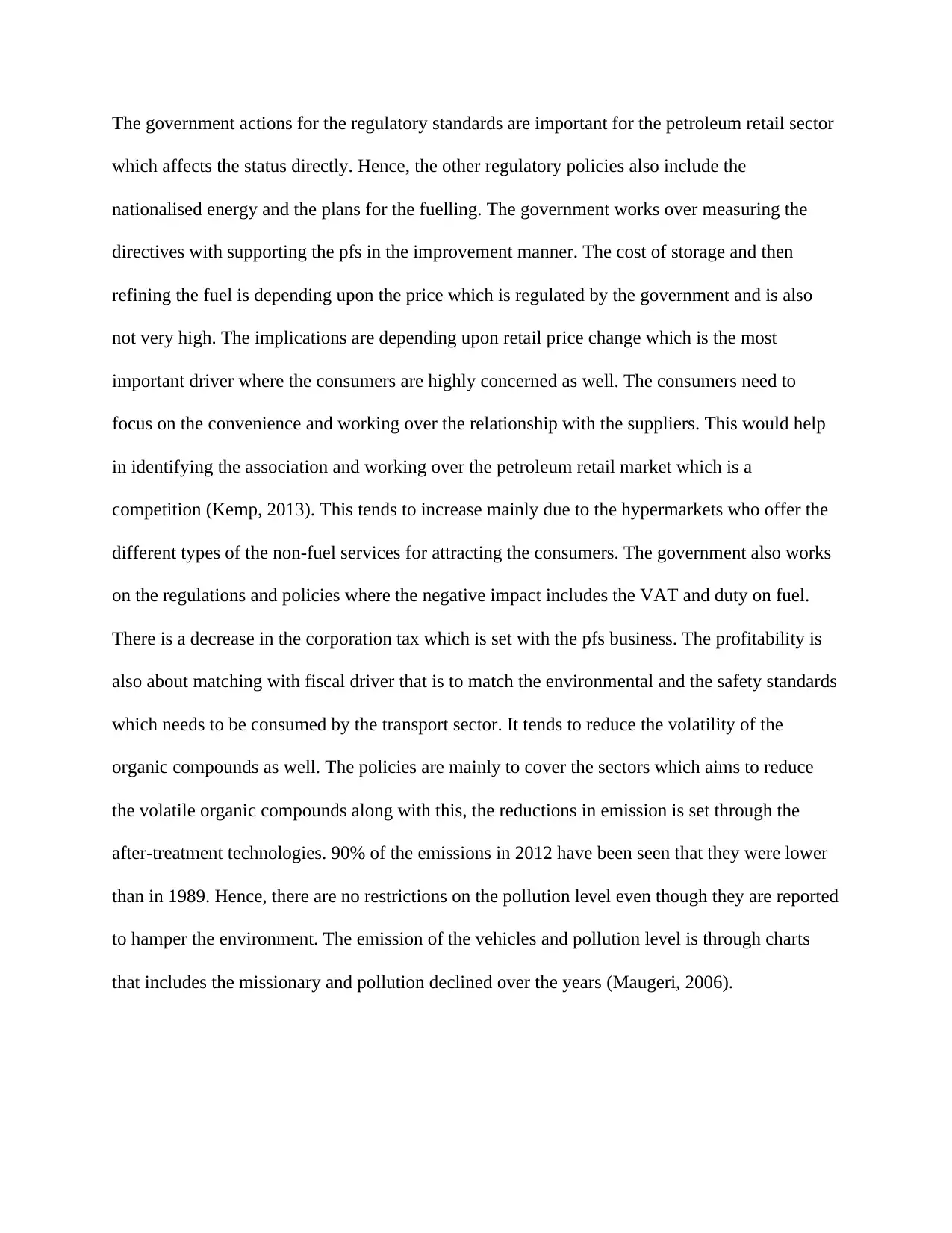
The government actions for the regulatory standards are important for the petroleum retail sector
which affects the status directly. Hence, the other regulatory policies also include the
nationalised energy and the plans for the fuelling. The government works over measuring the
directives with supporting the pfs in the improvement manner. The cost of storage and then
refining the fuel is depending upon the price which is regulated by the government and is also
not very high. The implications are depending upon retail price change which is the most
important driver where the consumers are highly concerned as well. The consumers need to
focus on the convenience and working over the relationship with the suppliers. This would help
in identifying the association and working over the petroleum retail market which is a
competition (Kemp, 2013). This tends to increase mainly due to the hypermarkets who offer the
different types of the non-fuel services for attracting the consumers. The government also works
on the regulations and policies where the negative impact includes the VAT and duty on fuel.
There is a decrease in the corporation tax which is set with the pfs business. The profitability is
also about matching with fiscal driver that is to match the environmental and the safety standards
which needs to be consumed by the transport sector. It tends to reduce the volatility of the
organic compounds as well. The policies are mainly to cover the sectors which aims to reduce
the volatile organic compounds along with this, the reductions in emission is set through the
after-treatment technologies. 90% of the emissions in 2012 have been seen that they were lower
than in 1989. Hence, there are no restrictions on the pollution level even though they are reported
to hamper the environment. The emission of the vehicles and pollution level is through charts
that includes the missionary and pollution declined over the years (Maugeri, 2006).
which affects the status directly. Hence, the other regulatory policies also include the
nationalised energy and the plans for the fuelling. The government works over measuring the
directives with supporting the pfs in the improvement manner. The cost of storage and then
refining the fuel is depending upon the price which is regulated by the government and is also
not very high. The implications are depending upon retail price change which is the most
important driver where the consumers are highly concerned as well. The consumers need to
focus on the convenience and working over the relationship with the suppliers. This would help
in identifying the association and working over the petroleum retail market which is a
competition (Kemp, 2013). This tends to increase mainly due to the hypermarkets who offer the
different types of the non-fuel services for attracting the consumers. The government also works
on the regulations and policies where the negative impact includes the VAT and duty on fuel.
There is a decrease in the corporation tax which is set with the pfs business. The profitability is
also about matching with fiscal driver that is to match the environmental and the safety standards
which needs to be consumed by the transport sector. It tends to reduce the volatility of the
organic compounds as well. The policies are mainly to cover the sectors which aims to reduce
the volatile organic compounds along with this, the reductions in emission is set through the
after-treatment technologies. 90% of the emissions in 2012 have been seen that they were lower
than in 1989. Hence, there are no restrictions on the pollution level even though they are reported
to hamper the environment. The emission of the vehicles and pollution level is through charts
that includes the missionary and pollution declined over the years (Maugeri, 2006).
⊘ This is a preview!⊘
Do you want full access?
Subscribe today to unlock all pages.

Trusted by 1+ million students worldwide
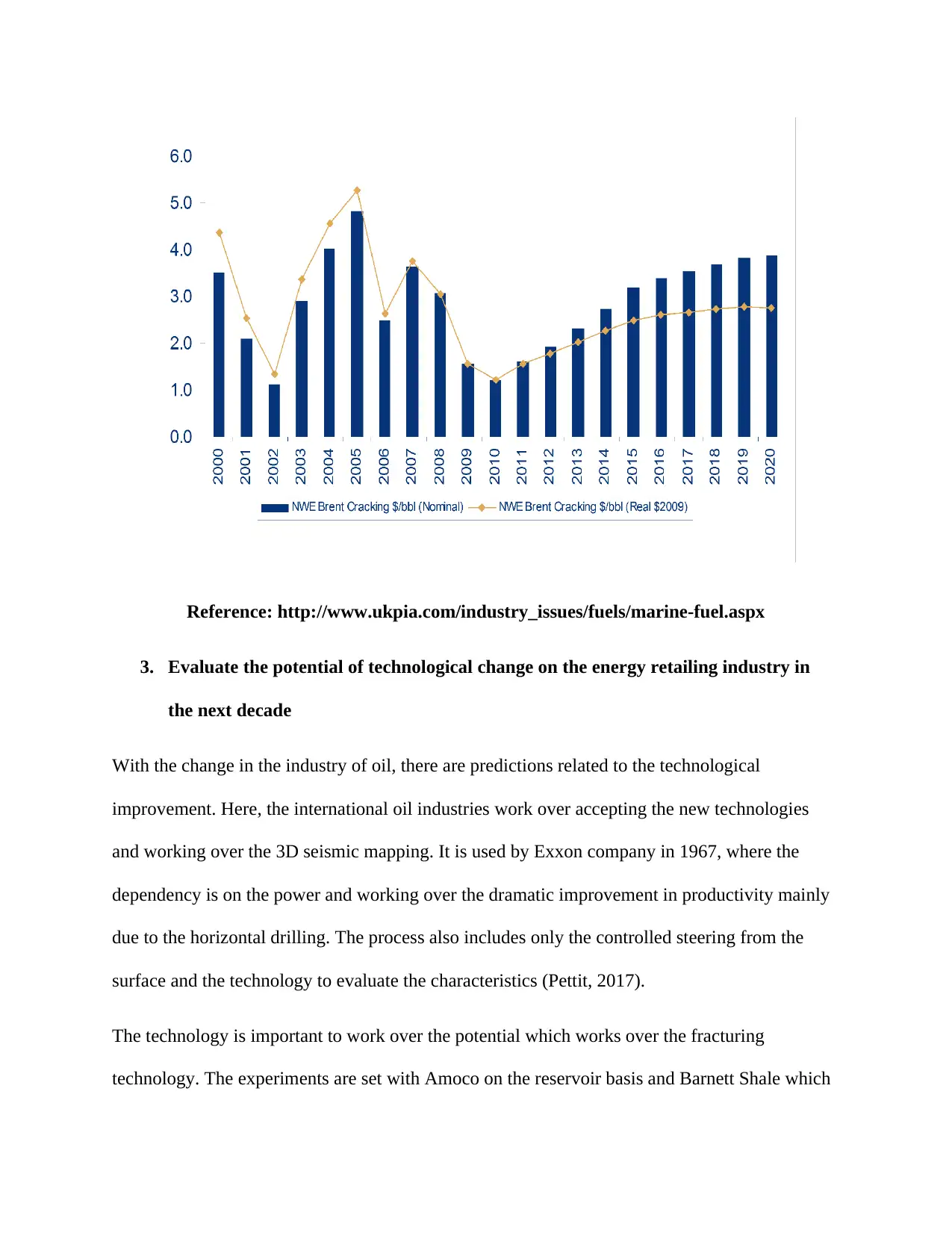
Reference: http://www.ukpia.com/industry_issues/fuels/marine-fuel.aspx
3. Evaluate the potential of technological change on the energy retailing industry in
the next decade
With the change in the industry of oil, there are predictions related to the technological
improvement. Here, the international oil industries work over accepting the new technologies
and working over the 3D seismic mapping. It is used by Exxon company in 1967, where the
dependency is on the power and working over the dramatic improvement in productivity mainly
due to the horizontal drilling. The process also includes only the controlled steering from the
surface and the technology to evaluate the characteristics (Pettit, 2017).
The technology is important to work over the potential which works over the fracturing
technology. The experiments are set with Amoco on the reservoir basis and Barnett Shale which
3. Evaluate the potential of technological change on the energy retailing industry in
the next decade
With the change in the industry of oil, there are predictions related to the technological
improvement. Here, the international oil industries work over accepting the new technologies
and working over the 3D seismic mapping. It is used by Exxon company in 1967, where the
dependency is on the power and working over the dramatic improvement in productivity mainly
due to the horizontal drilling. The process also includes only the controlled steering from the
surface and the technology to evaluate the characteristics (Pettit, 2017).
The technology is important to work over the potential which works over the fracturing
technology. The experiments are set with Amoco on the reservoir basis and Barnett Shale which
Paraphrase This Document
Need a fresh take? Get an instant paraphrase of this document with our AI Paraphraser
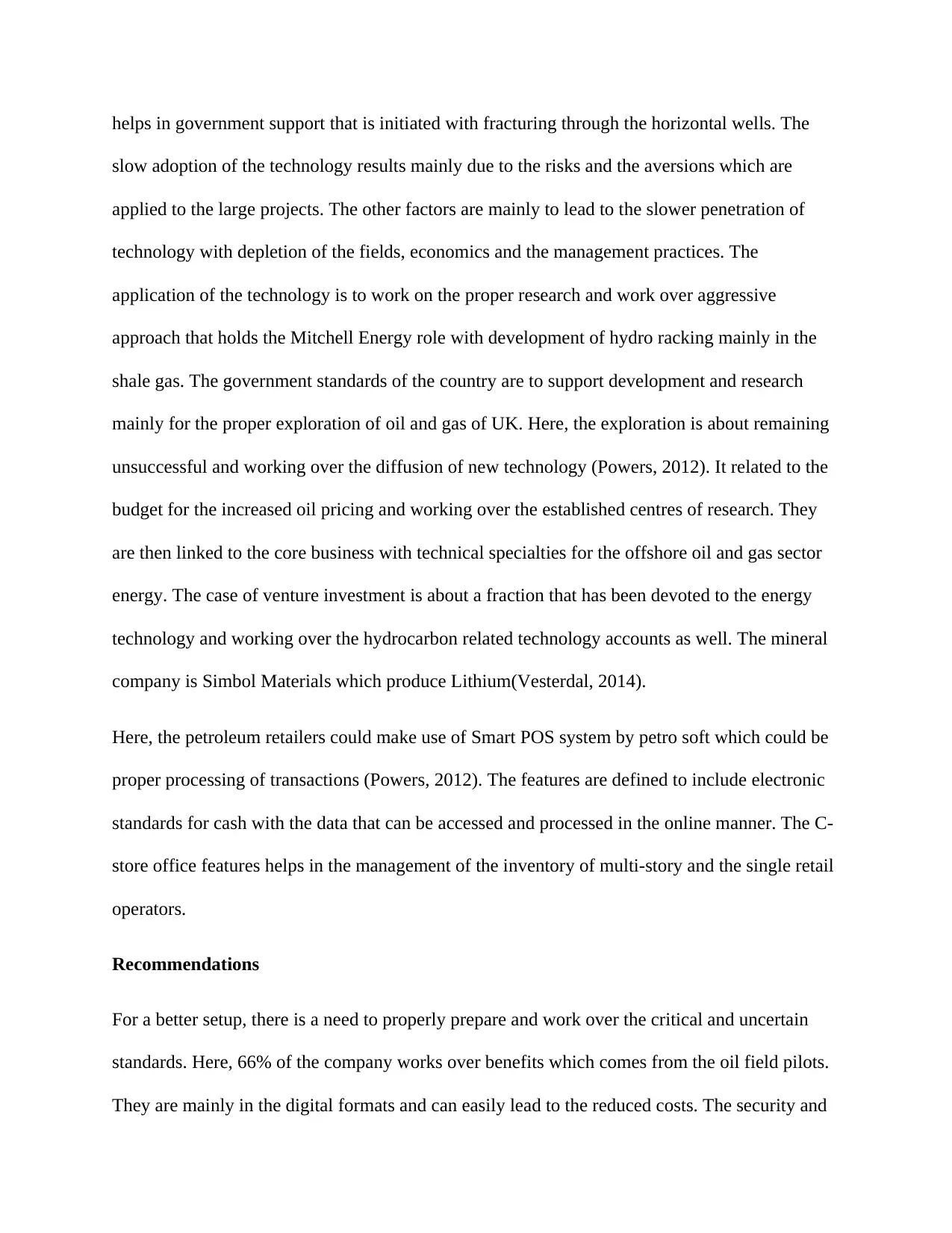
helps in government support that is initiated with fracturing through the horizontal wells. The
slow adoption of the technology results mainly due to the risks and the aversions which are
applied to the large projects. The other factors are mainly to lead to the slower penetration of
technology with depletion of the fields, economics and the management practices. The
application of the technology is to work on the proper research and work over aggressive
approach that holds the Mitchell Energy role with development of hydro racking mainly in the
shale gas. The government standards of the country are to support development and research
mainly for the proper exploration of oil and gas of UK. Here, the exploration is about remaining
unsuccessful and working over the diffusion of new technology (Powers, 2012). It related to the
budget for the increased oil pricing and working over the established centres of research. They
are then linked to the core business with technical specialties for the offshore oil and gas sector
energy. The case of venture investment is about a fraction that has been devoted to the energy
technology and working over the hydrocarbon related technology accounts as well. The mineral
company is Simbol Materials which produce Lithium(Vesterdal, 2014).
Here, the petroleum retailers could make use of Smart POS system by petro soft which could be
proper processing of transactions (Powers, 2012). The features are defined to include electronic
standards for cash with the data that can be accessed and processed in the online manner. The C-
store office features helps in the management of the inventory of multi-story and the single retail
operators.
Recommendations
For a better setup, there is a need to properly prepare and work over the critical and uncertain
standards. Here, 66% of the company works over benefits which comes from the oil field pilots.
They are mainly in the digital formats and can easily lead to the reduced costs. The security and
slow adoption of the technology results mainly due to the risks and the aversions which are
applied to the large projects. The other factors are mainly to lead to the slower penetration of
technology with depletion of the fields, economics and the management practices. The
application of the technology is to work on the proper research and work over aggressive
approach that holds the Mitchell Energy role with development of hydro racking mainly in the
shale gas. The government standards of the country are to support development and research
mainly for the proper exploration of oil and gas of UK. Here, the exploration is about remaining
unsuccessful and working over the diffusion of new technology (Powers, 2012). It related to the
budget for the increased oil pricing and working over the established centres of research. They
are then linked to the core business with technical specialties for the offshore oil and gas sector
energy. The case of venture investment is about a fraction that has been devoted to the energy
technology and working over the hydrocarbon related technology accounts as well. The mineral
company is Simbol Materials which produce Lithium(Vesterdal, 2014).
Here, the petroleum retailers could make use of Smart POS system by petro soft which could be
proper processing of transactions (Powers, 2012). The features are defined to include electronic
standards for cash with the data that can be accessed and processed in the online manner. The C-
store office features helps in the management of the inventory of multi-story and the single retail
operators.
Recommendations
For a better setup, there is a need to properly prepare and work over the critical and uncertain
standards. Here, 66% of the company works over benefits which comes from the oil field pilots.
They are mainly in the digital formats and can easily lead to the reduced costs. The security and
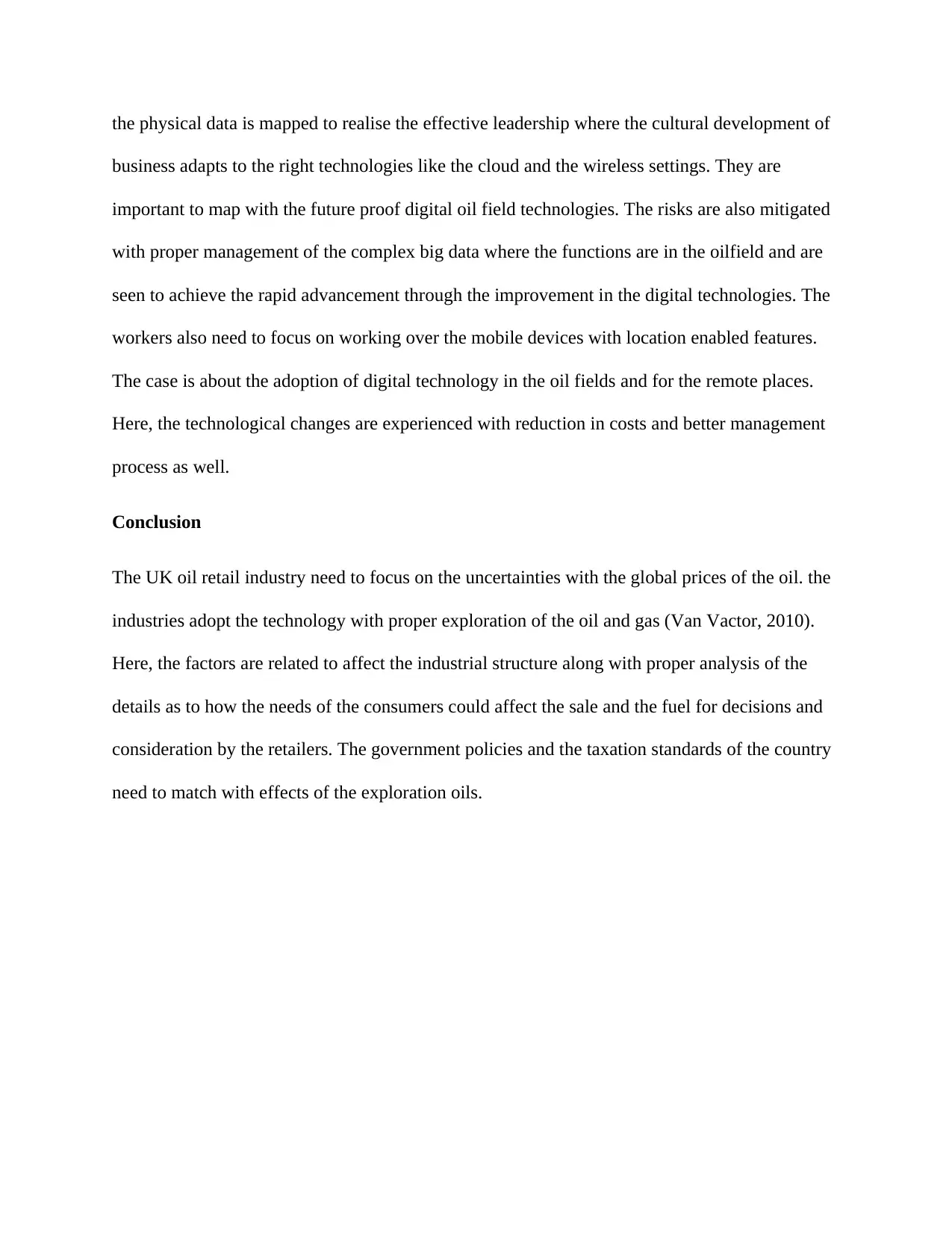
the physical data is mapped to realise the effective leadership where the cultural development of
business adapts to the right technologies like the cloud and the wireless settings. They are
important to map with the future proof digital oil field technologies. The risks are also mitigated
with proper management of the complex big data where the functions are in the oilfield and are
seen to achieve the rapid advancement through the improvement in the digital technologies. The
workers also need to focus on working over the mobile devices with location enabled features.
The case is about the adoption of digital technology in the oil fields and for the remote places.
Here, the technological changes are experienced with reduction in costs and better management
process as well.
Conclusion
The UK oil retail industry need to focus on the uncertainties with the global prices of the oil. the
industries adopt the technology with proper exploration of the oil and gas (Van Vactor, 2010).
Here, the factors are related to affect the industrial structure along with proper analysis of the
details as to how the needs of the consumers could affect the sale and the fuel for decisions and
consideration by the retailers. The government policies and the taxation standards of the country
need to match with effects of the exploration oils.
business adapts to the right technologies like the cloud and the wireless settings. They are
important to map with the future proof digital oil field technologies. The risks are also mitigated
with proper management of the complex big data where the functions are in the oilfield and are
seen to achieve the rapid advancement through the improvement in the digital technologies. The
workers also need to focus on working over the mobile devices with location enabled features.
The case is about the adoption of digital technology in the oil fields and for the remote places.
Here, the technological changes are experienced with reduction in costs and better management
process as well.
Conclusion
The UK oil retail industry need to focus on the uncertainties with the global prices of the oil. the
industries adopt the technology with proper exploration of the oil and gas (Van Vactor, 2010).
Here, the factors are related to affect the industrial structure along with proper analysis of the
details as to how the needs of the consumers could affect the sale and the fuel for decisions and
consideration by the retailers. The government policies and the taxation standards of the country
need to match with effects of the exploration oils.
⊘ This is a preview!⊘
Do you want full access?
Subscribe today to unlock all pages.

Trusted by 1+ million students worldwide
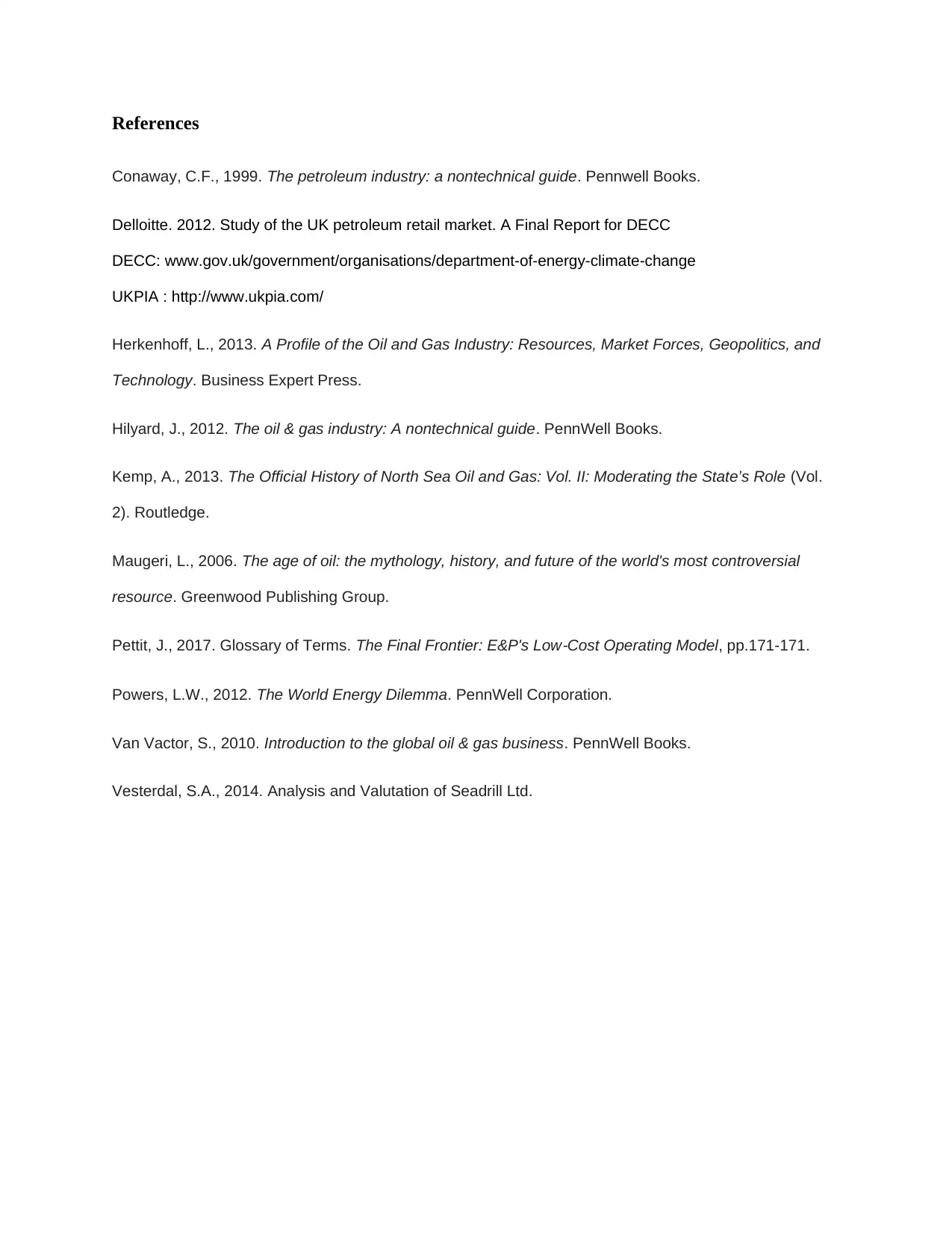
References
Conaway, C.F., 1999. The petroleum industry: a nontechnical guide. Pennwell Books.
Delloitte. 2012. Study of the UK petroleum retail market. A Final Report for DECC
DECC: www.gov.uk/government/organisations/department-of-energy-climate-change
UKPIA : http://www.ukpia.com/
Herkenhoff, L., 2013. A Profile of the Oil and Gas Industry: Resources, Market Forces, Geopolitics, and
Technology. Business Expert Press.
Hilyard, J., 2012. The oil & gas industry: A nontechnical guide. PennWell Books.
Kemp, A., 2013. The Official History of North Sea Oil and Gas: Vol. II: Moderating the State’s Role (Vol.
2). Routledge.
Maugeri, L., 2006. The age of oil: the mythology, history, and future of the world's most controversial
resource. Greenwood Publishing Group.
Pettit, J., 2017. Glossary of Terms. The Final Frontier: E&P's Low
‐Cost Operating Model, pp.171-171.
Powers, L.W., 2012. The World Energy Dilemma. PennWell Corporation.
Van Vactor, S., 2010. Introduction to the global oil & gas business. PennWell Books.
Vesterdal, S.A., 2014. Analysis and Valutation of Seadrill Ltd.
Conaway, C.F., 1999. The petroleum industry: a nontechnical guide. Pennwell Books.
Delloitte. 2012. Study of the UK petroleum retail market. A Final Report for DECC
DECC: www.gov.uk/government/organisations/department-of-energy-climate-change
UKPIA : http://www.ukpia.com/
Herkenhoff, L., 2013. A Profile of the Oil and Gas Industry: Resources, Market Forces, Geopolitics, and
Technology. Business Expert Press.
Hilyard, J., 2012. The oil & gas industry: A nontechnical guide. PennWell Books.
Kemp, A., 2013. The Official History of North Sea Oil and Gas: Vol. II: Moderating the State’s Role (Vol.
2). Routledge.
Maugeri, L., 2006. The age of oil: the mythology, history, and future of the world's most controversial
resource. Greenwood Publishing Group.
Pettit, J., 2017. Glossary of Terms. The Final Frontier: E&P's Low
‐Cost Operating Model, pp.171-171.
Powers, L.W., 2012. The World Energy Dilemma. PennWell Corporation.
Van Vactor, S., 2010. Introduction to the global oil & gas business. PennWell Books.
Vesterdal, S.A., 2014. Analysis and Valutation of Seadrill Ltd.
1 out of 10
Related Documents
Your All-in-One AI-Powered Toolkit for Academic Success.
+13062052269
info@desklib.com
Available 24*7 on WhatsApp / Email
![[object Object]](/_next/static/media/star-bottom.7253800d.svg)
Unlock your academic potential
Copyright © 2020–2025 A2Z Services. All Rights Reserved. Developed and managed by ZUCOL.





